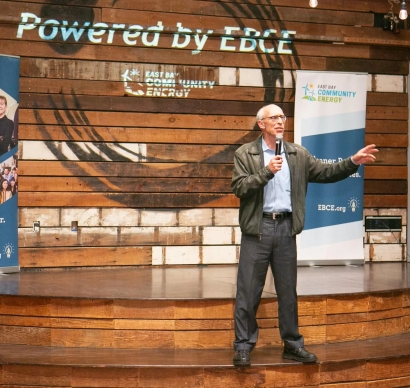
As EBCE moves toward a zero-emission power system over the next decade, a key technical problem is the evening peak. Plentiful and low cost solar power makes it easy to meet daytime power demand, but as the sun goes down something else needs to be available. Most often now that means burning natural gas in power plants, which is not zero-emission. EBCE is contracting for energy storage as one solution, but another is to cut demand in those evening hours.
One trick, for example, is to use a programmable thermostat to “pre-cool” a home on hot summer afternoons when solar power is cheap and abundant, then, turn off the air conditioner during evening peak hours. A well-insulated home can act as a “cool-energy” battery.
Those peak hours are also the most expensive times to buy power, driving up costs for all EBCE customers. Saving energy on peak saves money for everyone.
Traditional energy efficiency programs focus on installing a set of approved measures, like light bulbs, insulation, and energy efficient appliances. These measures reduce energy demand, no doubt, but program managers don’t know exactly how much or when. Because the savings are uncertain, they are valued less than they could be.
Through a new “Pay for Performance” approach, EBCE is paying energy efficiency contractors based on their ability to reduce demand during that evening peak, and to deliver verified savings to targeted customers.
In 2019, EBCE began developing Pay for Performance pilot programs aimed at single-family residential, commercial, and low-income residential customers. EBCE hired the firm Recurve to develop a dashboard that builds on EBCE’s in-house data analysis capabilities. EBCE’s early attention to data management helped accelerate the process by many months.
The dashboard analyzes customer loads in detail, creates baselines, and then tracks how customer load actually changes in response to energy measures. The dashboard is fed by the steady stream of sub-hourly data coming from smart meters, allowing EBCE to target the customers who would benefit the most from the program and deliver the highest value to EBCE.
Customers with high demand during evening peak hours (blue line) are filtered from the general population (red dotted line); programs then can target those customers with the most potential to save.
“For the low-income pilot, we can identify a customer on a rate discount program like CARE or FERA, who uses a lot of energy during peak hours,” says Beckie Menten, EBCE’s program manager for building electrification and energy efficiency. “Some low-income households spend as much as 12% of their income on energy, which is many times higher than more affluent customers.” This helps the customer save on their energy costs and decrease the proportion of their monthly income that needs to go towards utility bills.
“By providing specific efficiency improvements that cut their demand during expensive peak hours, we lower their bills, and we also reduce EBCE’s need to provide that power, which saves money for all our customers,” says Menten. “It will also help ease the transition to time-of-use rates, which phase in this year.”
All three pilot areas are enrolling customers now.
If the pilots succeed, EBCE hopes to scale up Pay for Performance by tapping ratepayer funded energy efficiency program budgets controlled by the California Public Utilities Commission.

